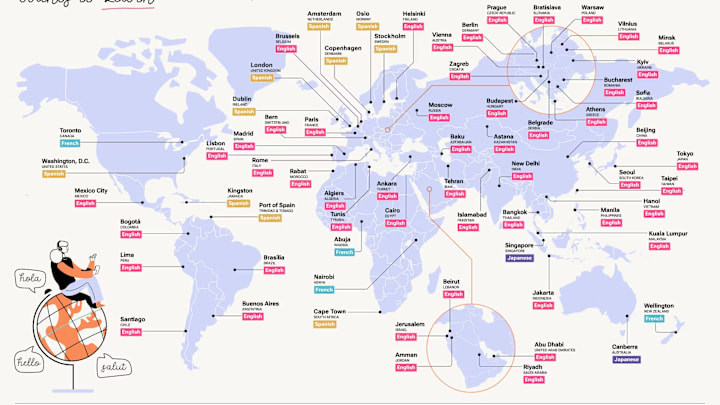What language would you most like to be able to speak?
Your answer to that probably depends on a lot of different factors, many of them unique to you. Perhaps you’d like to speak the language that is used closest to your home country, or maybe the language of some far-flung destination you’ve long wanted to visit is top of your list.
Then again, maybe your family history might affect your decision, and you want to learn a language that connects you to your roots. It’s also possible that your ideal language is nothing more than a hobby—a language with no connection to you or your home nation at all, but one that you just find interesting, unusual, or challenging.
Well, new research from language website Wordtips has unveiled the top language choice of learners in almost every capital city in the world, providing unique and fascinating insight into global language learning—and giving you the chance to compare your answer to other people in your home country.
By collating data from more than 280,000 profiles on the popular language-learning platform Conversation Exchange, the analysts at Wordtips noted the language currently being learned by the highest proportion of learners in every available national capital (and, in the case of the U.S., data from the five most populous cities in every state as well).
The results showed that English truly is the world’s most global language, coming out on top in 52 of the world’s capital cities, from Lima to Hanoi, Bogota to Ankara, and Cairo to Bangkok. Spanish came in a not-too-close second, proving the most popular language in 10 cities worldwide, followed by French in third, and Japanese in fourth.

The data threw up some intriguing trends too. Of those 10 Spanish-learning cities, six—including Washington, D.C., London, and Dublin—were the capitals of nations where English is an official or primary language, while the remaining four (Amsterdam, Oslo, Stockholm, and Copenhagen) lie clustered together in northern Europe. Cultural and historical ties may have made French the most popular choice in Toronto, the capital of Ontario Province, Canada (Ottawa, Canada’s capital, is not mentioned), while Japanese came out on top in Canberra, Australia, where it’s currently being learned by roughly one in every 10 school students [PDF].
There’s an intriguing generational divide as well: The analysis revealed that Spanish and French are the most popular languages being learned by all generations in the U.S., but after that, Boomers and Gen Xers were found to be keenest to learn Italian, while the popularity of the likes of K-Pop and anime among Gen Zs and Millennials saw them more likely to opt for Korean and Japanese.

When it came to the second-most popular language-learning choice in cities around the world, French took the silver medal position with 27 cities, followed by Spanish and German. There was at least one intriguing outlier: Baku, Azerbaijan, where the second-highest number of learners are studying Russian.

The extra data from the United States also showed that Spanish comes out on top in almost every city that was analyzed. French came in a close second in 80 percent of the cities (including almost all of those in New England and the Eastern Seaboard states) while Japanese came in second in 13 of the remaining cities. Another unique outlier was Silver Spring, Maryland, where the most popular language after Spanish was Italian.
You can more city-by-city data and generational breakdowns here, via Wordtips.
Read More Stories About Language:
This story has been updated to reflect that Wordtips’ map features Toronto, the capital of Ontario Province, Canada, and not Ottawa, the capital of Canada.
